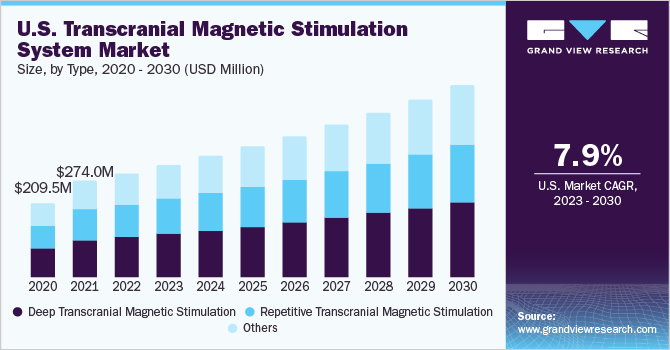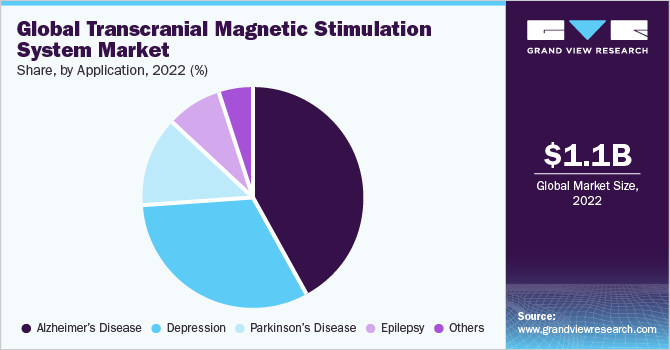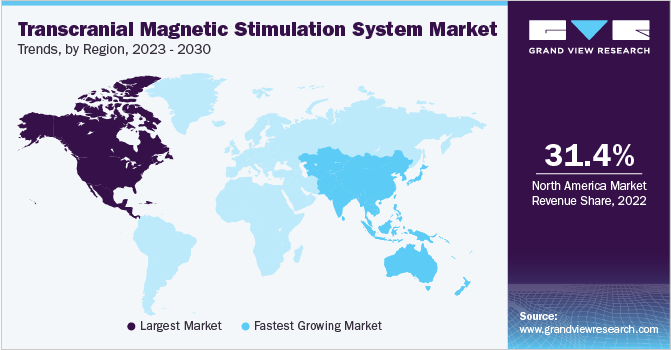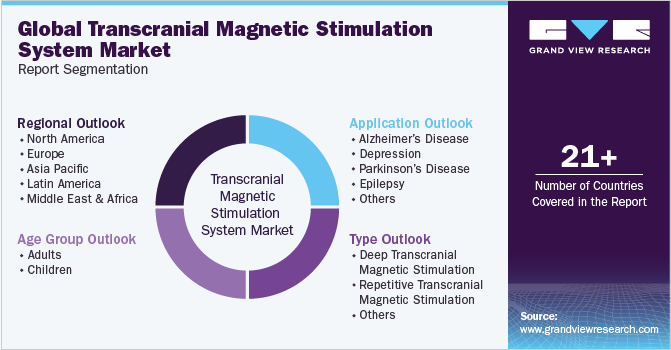- Home
- »
- Medical Devices
- »
-
Transcranial Magnetic Stimulation System Market Report 2030GVR Report cover
![Transcranial Magnetic Stimulation System Market Size, Share & Trends Report]()
Transcranial Magnetic Stimulation System Market Size, Share & Trends Analysis Report By Type (rTMS, dTMS), By Application (Depression, Epilepsy), By Age Group, By Region, And Segment Forecasts, 2023 - 2030
- Report ID: GVR-4-68039-914-1
- Number of Report Pages: 100
- Format: PDF, Horizon Databook
- Historical Range: 2018 - 2021
- Forecast Period: 2023 - 2030
- Industry: Healthcare
Report Overview
The global transcranial magnetic stimulation system market size was estimated at USD 1.13 billion in 2022 and is anticipated to grow at a compound annual growth rate (CAGR) of 9.0% from 2023 to 2030. Owing to technological advancements and the increasing incidence rate of Alzheimer's disease, Parkinson's disease, and other neurological conditions the prevalence of Alzheimer's disease is high among the geriatric population. According to the Texas Department of State Health Services, 5.0% of individuals within the age group of 65 to 74 years, 13.1% of those aged 75 to 84 years, and 33.2% of individuals aged 85 years and above are affected by this condition. The COVID-19 pandemic had a negative impact on the transcranial magnetic stimulation (TMS) systems market growth.

The pandemic directly impacted demand & production, disrupted the supply chain and increased the financial burden on firms. To restrict the spread of the COVID-19 virus, neurological procedures were frequently delayed or canceled. The worst-affected nations, including the U.S., Russia, India, Brazil, France, the UK, Italy, and Spain, witnessed a 55% decline in neurosurgical procedures. The increasing prevalence of Parkinson’s disease (PD) is a high-impact rendering driver for market growth. After Alzheimer's disease (AD), PD is the most common neurodegenerative disorder. It is caused by a combination of genetic mutations in the alpha-synuclein gene and external factors, such as repeated head injuries, with age being the major risk factor.
According to a report by the Parkinson’s Foundation Prevalence Project, the number of people living with PD will increase to 1.2 million by 2030, from 930,000 in 2020. This is more than the number of patients suffering from muscular dystrophy, multiple sclerosis, and amyotrophic lateral sclerosis. Approximately 60,000 people in the U.S. are diagnosed with PD every year. Its growing prevalence has raised the demand for DBS as an alternative therapy, which has proven to be vital in providing therapeutic solutions for PD symptoms. The growing demand for minimally invasive treatments for resistant neuropsychiatric conditions and neurological illnesses has increased interest in neuromodulatory techniques like TMS.
As the field of TMS treatment continues to advance, it is essential that clinical studies are meticulously planned and executed to define the efficacy of this therapeutic approach. Several initiatives are being undertaken by various organizations to generate awareness about PD and its current range of treatments. For instance, in April 2022, the Parkinson's Foundation announced the launch of the #FutureofPD campaign. The comprehensive project aims to promote awareness about PD while also highlighting activities that the entire community can do to help minimize the prevalence of the disease. Furthermore, in May 2021, the Parkinson's Foundation announced it would invest USD 10 million in programs for education, treatment, and research to better the lives of patients suffering from PD in the U.S.
An increasing number of studies on TMS and higher success rates are expected to provide better growth potential for these systems during the forecast period. Currently, a large number of ongoing studies on TMS systems are being performed in developed economies, including the U.S. and Canada, along with some countries from Latin America and Europe. A significant increase in the number of ongoing studies and growing demand in developing economies of the Middle East, Asia Pacific, and Australia regions have been observed in recent years. Increasing awareness about newer technologies and high demand for noninvasive neuro-therapeutic solutions are expected to fuel the market growth during the forecast period.
Type Insights
The repetitive TMS (rTMS) segment dominated the market with the largest revenue share of 38.5% in 2022. rTMS, a non-invasive technique for brain stimulation, utilizes electromagnetic induction facilitated by an insulated coil. This method targets a specific region of the brain believed to be crucial for regulating mood, with the coil positioned over the scalp. The coil emits gentle magnetic pulses that penetrate the scalp and reach the brain, resembling the pulses generated by MRI devices. The application of these pulses in rapid succession, known as rTMS, can induce enduring alterations in brain activity.
The deep TMS (dTMS) segment is expected to grow at the fastest CAGR of 9.5% during the forecast period. dTMS is a non-invasive and non-drug treatment method for patients suffering from depression. dTMS, along with H1 coil, is approved by the FDA for the treatment of patients with treatment-resistant depression. This is the safest treatment option with minimal or no risk/side effects. The usual treatment course involves sessions of 20 minutes, 5 days per week for 4 to 6 weeks. This procedure can be easily integrated into a patient's routine.
Application Insights
The Alzheimer's disease segment dominated the market with the largest revenue share of 41.5% in 2022. The conditions analyzed under this segment include bipolar disorder, autism, multiple sclerosis, and schizophrenia. Healthcare providers recommend rTMS for patients with negative symptoms, such as lack of speech and flattened emotional response. In most studies, schizophrenia affects men and women equally, but it is more likely to develop in males. It is mainly caused by genetic and environmental factors. Thus, the increasing prevalence of diseases, such as schizophrenia, multiple sclerosis, autism, and bipolar disorder, is expected to boost the segment growth. The depression segment is expected to grow at the fastest CAGR of 9.5% over the forecast period.

Depression is a type of mood disorder, which may be defined as feeling lost, sad, or angry and it interferes with the everyday activities of a patient. According to the CDC, in 2022, approximately 4.91% of U.S. adults experienced severe mental illness and 19.85% of the U.S. adults experienced mental illness. Depression affects each individual differently and it could impact daily work, reduce productivity, create chronic health conditions, and negatively impact personal relationships. Various chronic conditions that may get worse with depression are cardiovascular conditions, Diabetes, Obesity, Asthma, Cancer, and Arthritis. Depression symptoms vary from mild to severe and can lead to different physical & emotional conditions, impacting an individual’s ability to handle situations at home and work. Early symptoms of depression vary in men, women, and children.
Age Group Insights
The adults segment dominated the market with the largest revenue share of 58.5% in 2022. Epilepsy is becoming more common in developing countries, which has increased the demand for affordable, efficient treatment alternatives with long-term advantages. In turn, it is projected that this will fuel market expansion in the coming years. In the U.S., 3 million adults had active epilepsy in 2021, according to the CDC. Increased community awareness, favorable laws and regulations, and government actions will drive the segment's growth in the near future.
In addition, all of the political and regulatory elements are covered, indicating the attractive chances for the major firms to enter these markets. Growing knowledge of cutting-edge epilepsy treatment options and expanding healthcare infrastructure are anticipated to further propel segment growth. The children segment is expected to grow at the fastest CAGR of 9.2% over the forecast period. The factors driving the segment are a surge in the incidence of neurological disorders, growing awareness about TMS, and improving healthcare infrastructure in emerging economies.
In addition, supportive government policies and laws of the countries are boosting the growth of the segment. Moreover, some countries have supportive reimbursement policies, which are anticipated to increase the sales of TMS in those regions. A rise in the prevalence of mental disorders, such as depression, and high demand for mental health services among children are expected to drive segment growth. According to Youth Mental Health Canada, only 9% of the healthcare budget in Canada is spent on mental health. Thus, limited spending on mental healthcare is impeding market growth.
Regional Insights
North America dominated the market with the largest revenue share of 31.4% in 2022. The significant investments by governments for the development of innovative medical devices, the presence of key participants, and the presence of a favorable reimbursement scenario are supplementing the growth of the market in the region. Due to the rising incidence of chronic kidney diseases (CKD), there is increasing demand for home dialysis. The presence of streamlined processes, such as hospital admissions and claiming reimbursements, in healthcare facilities and the availability of integrated healthcare IT products to maintain Electronic Health Records (EHRs) are some of the factors responsible for the largest revenue share held by this region. Strategies adopted by companies for the launch of products are anticipated to increase the competition in the market.

The Asia Pacific region is estimated to register the fastest growth rate over the forecast period. The rising focus of companies on expanding their presence in this region and the growing demand for TMS systems are expected to drive market growth. In addition, rising R&D activities, increasing healthcare expenditure, and easy availability of low-cost healthcare IT products are anticipated to drive market growth. As manufacturers in Asia Pacific are focusing on the development of low-cost products with higher efficiency, the market is anticipated to witness significant growth over the forecast period. In addition, global players are investing in local companies as raw materials and labor are available at low costs in the emerging economies of Asia Pacific.
Key Companies & Market Share Insights
Key players adopt strategies, such as M&As, partnerships, product launches, geographic expansions, improvement & expansion of the distribution networks, and innovations, such as the introduction of transcranial magnetic stimulation system products, to strengthen their foothold in the global market. For instance, in July 2022, the FDA approved the NeuroStar Advanced Therapy for Mental Health transcranial magnetic stimulation device to treat anxiety symptoms in people with major depressive disorder. Technological advancements are anticipated to create significant growth opportunities in the market. For instance, in August 2021, the U.S. FDA granted clearance to BrainsWay’s Deep Transcranial Magnetic Stimulation (Deep TMS) System.
The company can market its products to reduce anxiety comorbid symptoms with depression in adult patients, also known as anxious depression. In November 2021, Magstim, a provider of neuroscience-based mental health care and research, received a 510K clearance for Horizon 3.0. Horizon 3.0 delivers improved workflows with navigated TMS and analytics as it was specifically created for the clinical setting. Providing connected care at networked sites, Magstim Connect is a new and potent patient data management solution for TMS, which is expected to enhance market growth in the near future. Some of the major participants in the global transcranial magnetic stimulation system market include:
-
BrainsWay
-
Magstim
-
Nexstim
-
Salience
-
MagVenture A/S
-
eNeura Inc.
Transcranial Magnetic Stimulation System Market Report Scope
Report Attribute
Details
Market size value in 2023
USD 1.23 billion
Revenue forecast 2030
USD 2.26 billion
Growth rate
CAGR of 9.0% from 2023 to 2030
Base year for estimation
2022
Historical data
2018 - 2021
Forecast period
2023 - 2030
Report updated
September 2023
Quantitative units
Revenue in USD million/billion and CAGR from 2023 to 2030
Report coverage
Revenue forecast, company ranking, competitive landscape, growth factors, and trends
Segments covered
Type, application, age group, region
Regional scope
North America; Europe; Asia Pacific; Latin America; MEA
Country scope
U.S.; Canada; UK; Germany; France; Italy; Spain; Denmark; Sweden; Norway; China; Japan; India; Australia; South Korea; Thailand; Brazil; Mexico; Argentina; Saudi Arabia; South Africa; UAE; Kuwait
Key companies profiled
BrainsWay; Magstim; Nexstim; Salience; MagVenture A/S; eNeura Inc.
Customization scope
Free report customization (equivalent up to 8 analyst’s working days) with purchase. Addition or alteration to country, regional & segment scope
Pricing and purchase options
Avail customized purchase options to meet your exact research needs. Explore purchase options
Global Transcranial Magnetic Stimulation System Market Report Segmentation
This report forecasts revenue growth at global, regional, and country levels and provides an analysis of the latest trends in each of the sub-segments from 2018 to 2030. For this study, Grand View Research has segmented the transcranial magnetic stimulation system market report on the basis of type, application, age group, and region:

-
Type Outlook (Revenue, USD Million, 2018 - 2030)
-
Deep Transcranial Magnetic Stimulation
-
Repetitive Transcranial Magnetic Stimulation
-
Others
-
-
Application Outlook (Revenue, USD Million, 2018 - 2030)
-
Alzheimer’s Disease
-
Depression
-
Parkinson’s Disease
-
Epilepsy
-
Others
-
-
Age Group Outlook (Revenue, USD Million, 2018 - 2030)
-
Adults
-
Children
-
-
Regional Outlook (Revenue, USD Million, 2018 - 2030)
-
North America
-
U.S.
-
Canada
-
-
Europe
-
UK
-
Germany
-
France
-
Italy
-
Spain
-
Sweden
-
Norway
-
Denmark
-
-
Asia Pacific
-
Japan
-
China
-
India
-
Australia
-
Thailand
-
South Korea
-
-
Latin America
-
Brazil
-
Mexico
-
Argentina
-
-
Middle East and Africa
-
Saudi Arabia
-
South Africa
-
UAE
-
Kuwait
-
-
Frequently Asked Questions About This Report
b. The global transcranial magnetic stimulation system market size was estimated at USD 1.13 billion in 2022 and is expected to reach USD 1.23 billion in 2023.
b. The global transcranial magnetic stimulation system market is expected to grow at a compound annual growth rate of 9.0% from 2023 to 2030 to reach USD 2.26 billion by 2030.
b. Repetitive Transcranial Magnetic Stimulation (rTMS) dominated the transcranial magnetic stimulator market with a share of 38.5% in 2022. This is attributable to increasing preference by the surgeons and increased application of rTMS.
b. Some of the key players operating in the transcranial magnetic stimulation system market include BrainsWay Ltd., Nexstim Plc, Magstim; Neuronetics, Inc.; TMS Neuro Solutions, MagVenture, and eNeura, Inc.
b. Key factors that are driving the transcranial magnetic stimulation system market growth include Increasing prevalence of neurological disorders, technological advancements, increasing awareness towards products, and increasing incidence of psychological disorders.
Share this report with your colleague or friend.
![gvr icn]()
NEED A CUSTOM REPORT?
We can customize every report - free of charge - including purchasing stand-alone sections or country-level reports, as well as offer affordable discounts for start-ups & universities. Contact us now
![Certified Icon]()
We are GDPR and CCPA compliant! Your transaction & personal information is safe and secure. For more details, please read our privacy policy.
We are committed towards customer satisfaction, and quality service.
"The quality of research they have done for us has been excellent."





